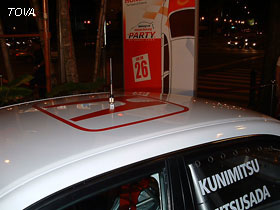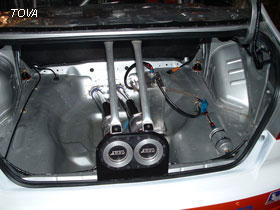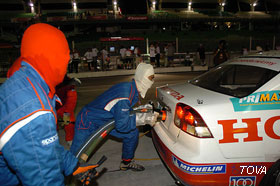

Compared to previous generation Civics, the biggest difference on the current Civic would be its use of a MacPherson strut system for the front though the rear still retains the multi-link system. This of course has not gone down well with Civic fans. Therefore for the area of handling, I was most curious how the MME Civics fare.
I asked HMRT about the handling of the Civics as compared to the class-winning DC5 ITRs of last year and was quite surprised to hear that both Team Kunimitsu and Mugen themselves feel the Civic handles better and is more stable in the corners. This apparently is due to the longer wheelbase of the Civic as compared to the DC5s. In this aspect, I was told the Civics could be tuned to give better handling than even the mighty DC5 ITRs. Very surprising. But of course professionals knows what they are talking about. Both the Civics this year qualified with faster lap times than the DC5s of last year. In fact even their fastest lap-times in the race itself are also faster than the qualifying times of last year !
Then, during my chat with Eddie Liew, one of the drivers of car no 27 who won the race, I asked him for comparison between the handling of this Civic as compared to the EK Civics that he have been racing with great success in the past. Again I was very surprised to hear Eddie tell me that he felt there were 'no difference' in the handling abilities of the two cars. Indeed, after testing the cars, he was confident of competing with the Porsches, Lotuses, even the 4WD EVOs in the corners.
Finally in my race coverage, I mentioned that one of my Honda club members Shedden raced an EK-Civic in Class C (1.6l cars). His base car was actually an original EK9 Civic Type-R though rather unusually they had the original B16B engine replaced by a built B16A engine for the race (to ensure reliability), keeping the B16B instead as a spare. In our discussions after the race, amongst his comments was his experience when he was being lapped by the HMRT Civics.
(The) HMRT Civics were doing very well, I really had a good time trying to be ahead of them, but then the blue flag was waved to me and I had to let them past. (Then) I had a good time trying to keep up with them. The HMRT Civics were not incredibly fast in the straights as I was able to follow them all the way but they were extremely fast in corners, especially at those high-speed sweeping corners and uphill bends. (Those) cars really handle like go karts man, especially with the Michelin tyres they were using, a real advantage over those who were using Silverstones, ... eventhough both are slicks
Solid testimonials then for the handling abilities of the Civics indeed ! The max speed of the HMRT Civics on the Sepang main straights were only around 205-210kph, nothing spectacular as stock Mitsubishi EVO-7s are able to hit similar speeds, so the Civics must really be extremely fast in the twisty sections !
To complete this article I now take a close look at the suspension, chassis and racing cabin of the HMRT Civics.
During race-time, the LCD displays the Mugen virtual dashboard which comprises tacho, speedo and various engine parameters including a lap time counter at the bottom left hand side. There are two 'versions' as shown in the photos, one showing standard analog dials and another using number displays and a 'climbing scale' display for engine revs similar to that used on the Honda S2000. When the ECU initializes during start-up time, the Mugen logo will flash briefly on the screen before the selected mode is displayed. The multi-LED device above the LCD is the shift-light but was not used for the race. The drivers were actually short-shifting most of the time in the race, especially when in 5th, they will short shift early into 6th to try to preserve engine health as much as possible. Interestingly I later learned that only 1 car, car no 26 actually raced with the LCD display. The LCD for car no 27 failed earlier and the regular DC5 instrument cluster had to be used for race day. This was sort of 'shoe-horned' into the standard Civic 2.0 i-VTEC's dash and the ill-fitting instrument cluster glass can be clearly seen in the photos. |


 Radio System
Radio System
The radio used for car to pits communication is supplied by Kenwood, the radio antenna very prominent on the roof of the cars. The MME runs for 12 hours, from 10am in the morning right until 10pm at night. Indeed the final and probably most crucial last 2-3 hours of the race is run in darkness. The headlights are still original Civic 2.0 i-VTEC items and I was surprised the DC5 ITR HIDs weren't swapped over. MME rules forbids any form of flashing lights on the cars so to identify the cars during the night portion, both Civics were fitted with red identification lights on the roof. |


 Refuelling System
Refuelling System
MME rules permits the use of an alternate refueling system over the original one that comes with the car provided the system (including fuel tank) is FIA or ASN approved. HMRT fitted their Civics with an Aero Tec Laboratory (ATL) 'Dual Dry Break' system as used in JGTC race-cars and the like. This system is fully FIA compliant and uses two side-by-side nozzles. Fuel is fed in through one nozzle, the 'dry break nozzle' while at the same time vapours escaping from the fuel tank is collected by the other nozzle and fed through a hose back to the overhead fuel reservoir tank, thus the dual nozzle-dual hose design. The 'male' (fuel feed) and 'female' (vapour collector) halves of the ATL Dual Dry Break system are precision machined to be self-aligning for fast bind-free action. This system of course gave HMRT one of their biggest advantage during the race, in the pit-stops. The original fuel tank was maintained and an auxilliary fuel container was added to prevent fuel starvation during cornering. The racing fuel pump is a Borsch racing pump and features prominently inside the boot area of the cars. |
Like the DC5s of last year's MME, the MME Civics this year are also equipped with an integrated compressed air jacking system according to HMRT, sourced from the U.K. A 3-point jacking system was adopted; 2 points in front and 1 point right at the rear of the car just beneath the boot cover. The compressed air intake nozzle is mounted on the front of the car, near the front grille. I was told the 'speed' of the air-jacks are a little bit too 'powerful' for the Civic's weight, i.e. they operate too fast but after some local modifications, were useable. In the race, this along with the special refueling system allowed HMRT to conduct very fast and effective pit-stops and are one of the key advantages over other teams most of who had to resort to the standard lever operated hydraulic-type ground jacks. |
This then is the 'anatomy' of the 2004 12 hours Merdeka Millennium Endurance champion, the HMRT Honda Civic 2.0 i-VTEC. In absolute terms, what has been done to change the road-cars into the winning race cars is nothing spectacular or special. Indeed except for items which are unuseable due to practical and legal reasons (e.g. roll-cage, the ATL refueling system, completely stripped interior), an owner of a Civic 2.0 i-VTEC can actually built up his/her car to specs similar to the HMRT MME Civic and it will still be road-worthy ! But bear in mind, these are the same race-cars that just took on and defeated Porsche 911 GT3s, 190ps Lotuses, EVOs and all sorts of 'super'-cars in the MME race ! And this is on a race-track which is FIA 'sanctioned' and considered good enough to host the highest levels of professional racing : Formula-1, MotoGP, Japan GT Championship and recently, even Formula Nippon (Formula-3000).
Now, eventhough the HMRT's Civics defeated Porsche 911s, Lotus and EVOs to win the race outright, it is still important to keep a sense of perspective and owners of modified Civic 2.0 i-VTECs are of course well advised to not go around challenging one of these cars on the open roads for a race because they will most definitely get creamed ! But then again, on suitably tight winding roads, it is now also proven that a suitably modded Civic 2.0 i-VTEC will not be embarassed or bullied by these cars either.
In the end, the spectacular achievements of the HMRT Civics proves that the Civic 2.0 i-VTEC in its basic form, is a very well designed and a very fast and capable car. For the hard-core enthusiasts, it has a lot of hidden potential just waiting to be tapped and unleshed and with their fantastic victory in the 2004 MME, Honda Malaysia has now proven to many sceptics that their Honda Civic 2.0 i-VTEC is a car to be respected, even feared ! And with this year's race won, we can look forward to next year's race and to HMRT defending their title. We won't know what car HMRT will use but based on this year's effort, we can be sure it's going to be another spectacular and exciting one !
Special Exclusive : The MME champion, car no 27 HMRT Civic is currently on a road-show tour around the country. At the moment, the road-show is being held at the 1-Utama shopping mall. Keep a look-out for the remaining dates and venues in the newspapers. Enthusiastic readers might want to take a hardcopy of this article along during their visit to the road-show and try to match the photos here to the actual cars !
Wong KN
September 2004
© Temple of VTEC Asia